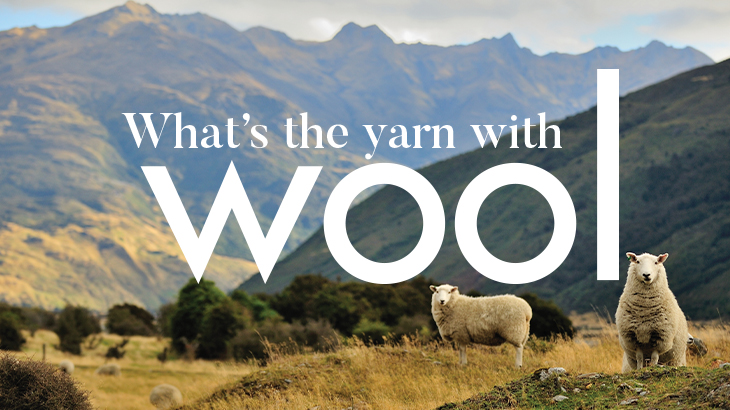What’s the yarn with wool
Over the past 15 years the primary sector has proven again and again its ability to weather some tough global times. The global financial crisis put some economies on their knees, but thanks to strong commodity prices New Zealand held up and even thrived.
Expectation is that primary sector trade values will continue to hold their own while the world adopts to its new reality, however the wool industry continues to demonstrate how polarising returns can be.
Strong wool returns are a far cry from the boom days of the early ‘50s when the price of wool tripled overnight, and it suddenly became worth almost a “pound for a pound.” This contrasts with its finer merino-sourced cousin which has surged and in 2019 accounted for 25 percent of the wool export value but was only seven percent of the total volume.
Whether it is fine merino or strong wool, many attributes of New Zealand-produced wool are exactly the same – both natural fibres are sustainably produced. However, what appears to be a key difference is the way organisations like The New Zealand Merino Company have carefully aligned the attributes of merino wool with its target market and organised an entire supply chain to satisfy consumer demand.
As a result, farmers are producing high quality fibre and are being offered appealing contracts for prices more than $20 a kilogram from high profile brands like North Face, Timberland and Smartwool.
More recently, Icebreaker, Allbirds and Smartwool announced they are going a step further to procure “regenerative” wool, to continue their move to natural. While these are relationships and prices strong wool neighbours can only dream about, there does appear to be a glimmer of hope on the horizon.
Taking a lead from its fine wool cousins, the strong wool sector has been seeking out some exciting new innovative products coming from the country’s most sustainable fibre source.
The jumpstart for strong wool’s revival came from the Wool Industry Project Action Group, releasing a report last year aimed to make the sector stronger and more profitable.
Its recommendations to help the sector thrive include developing a market-focused strategic roadmap for the sector, establishing capability to make the sector “match fit” and establishing governance and coordination capability.
Scoping the opportunity
The Strong Wool Action Group (SWAG) group has enjoyed a positive start to the first half of the year. The group was formed last year with the job of breathing new life into the wool sector in the wake of the report and is aiming to bank $3 million in a budget to better identify opportunities to add value to New Zealand strong wool.
Rob Hewett, chairman of SWAG is upbeat about the mood and co-operation he sees in the strong wool sector to improve its lot.
The group has already commissioned research into consumer behaviour and attitudes to wool products in a COVID environment, with results and recommendations due later this year.
“We know people are wanting to re-engage around sources of verifiably safe and sustainable food and products in their homes, including furnishings and fabrics.”
While carpets and furnishing fabrics have long formed a stalwart for wool use, he sees plenty of opportunity remaining in those sectors as consumers swap out synthetics for more natural, proven product.
“But you can’t just rely on that. We see more opportunity in areas like insulation and acoustic use, and in pharmaceutical products and absorbency products like nappies.”
Tom O’Sullivan, chairman of the Campaign for Wool New Zealand Trust says this newly formed body will also not only lift awareness of wool, but hopefully deliver some real commercial gains driven by a lift in wool demand.
O’Sullivan is well motivated to see some constructive outcomes from the campaign and says there are two things currently driving the sector to improve, the first of which is the risk of becoming a sunset industry, while the other is the enormous opportunity driven by an increase in conscious consumers.
“Globally there is a real move by consumers to seek out environmentally sustainable products, and this is only growing, which puts wool in a very good position to replace synthetics.”
He says accepting the ‘status quo’ is simply not an option.
“What has been done by Merino NZ and the fine wool sector provides something for strong wool to mirror.”
When Jeremy Moon brought Icebreaker to the world in the mid ‘90s, critics believed the sun was setting on the wool industry, given consumer preferences were moving towards cheaper, lighter synthetic alternatives.
Icebreaker stuck to its guns, determined to produce garments “born from nature and worn in nature”.
O’Sullivan says his group is sponsoring several initiatives, including better educating designers and architects about wool’s role and sustainable place in office and home interiors and construction.
“We really want to not only lift the level of awareness of wool, but also see greater commercial outcomes, and are keen to work with any companies that are in that area to help them lift their profile.”
Read more...
[Download PDF]Subscribe to receive the latest rural news and insights from Bayleys’ Country magazine.
